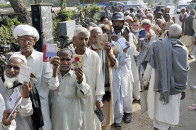Regaining power in K-P: How independents sway election results
Myth that K-P never re-elects overshadows power of independents

PHOTO: REUTERS
The electoral pattern showed K-P re-electing the Pakistan Muslim League-Nawaz (PML-N) thrice and Pakistan Peoples Party twice into power – although not in an ascending order.
The north-western province’s voting trend further highlights that the myth overshadowed the politics of independents. Since 1988, K-P’s independents have played a large role in shaping the assembly aisle with 15 independents elected in 1988 to 13 in 1990, 10 in 1993, 15 in 2002, 22 in 2008 and 14 in 2013 – raising the absorption of independents into governments to 85 per cent.
In this year's elections, a total of 1,165 candidates are contesting the upcoming general elections – out of which 505 are independents.
The number includes disgruntled PTI members who filed nomination papers as independents after being denied party tickets. Owing to differences with JI and Jamat-e-Ulema-e-Islam (JUI), the PTI leaders avoided contesting under the banner of MMA.
Curtain falls on electioneering
For ANP, relying on the voting pattern of five districts including Peshawar, Mardan, Charsadda, Nowshera and Swabi may be detrimental keeping in view that the 37 general seats from said districts cost them power in 2013. Despite the speculation over MMA uniting vote bank of JI and Jamat-e-Ulema-e-Islam (JUI), the coalition lacks luster to fence a strong opposition. Even in 2002, when the MMA contested as a united front for right-wing, it needed backing of six right-wing political parties to form majority.
When the number of general seats in the provincial assembly were increased to 99 in 2002 with 22 reserved for women and three for minorities, the total strength of K-P assembly stood at 124.
In the same year, the Muttahida Majlis-e-Amal (MMA) reigned into power while Awami National Party (ANP) emerged a winner in 2008 and formed a coalition with PPP. Come 2013, Imran Khan-led PTI partnered with the Jamat-e-Islami (JI) to form the provincial government.
How to vote on July 25
Historically, the voters in K-P tend to go against the tide with a divided vote bank. The voting trend varies across the province – with Hazara belt, central and southern parts dancing to their own tunes.
A determining factor in the upcoming polls is the increase of 3.05 million voters since 2013, raising the number from 12.266 million to 15.316 million combined with the expected surge in voter turnouts for youth and women. However, the string of security threats may hinder the mobilisation of voters on the polling day.



















COMMENTS
Comments are moderated and generally will be posted if they are on-topic and not abusive.
For more information, please see our Comments FAQ